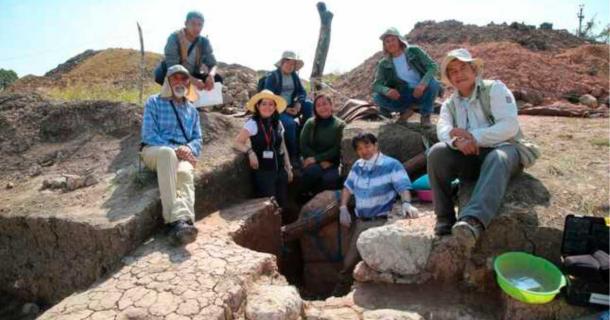Possible Priest’s Grave Discovered at Pacopampa
A team of archaeologists have discovered what they believe to be the tomb of a religious leader from ancient Peru at the Pacopampa site, a priestly figure, who was baptized as the “priest of the pututos,” or the priest of the shell trumpets.
The Pacopampa priest’s tomb remains have been dated to around 1000 BC. He was buried with musical instruments and an assortment of exotic objects.
Pacopampa is located in the province of Chota in the larger Cajamarca region. The tomb was located in the “La Capilla” building, and the man in the Pacopampa priest’s tomb was between 25 and 35 years of age, as reported by Agency Andina. Two other tombs have also been previously found at the site: the Lady of Pacopampa, who died in 750 BC (discovered in 2009), and the Serpent Jaguar Priest, from 700 BC (uncovered in 2015).

The Pacopampa Priest’s Tomb: Uncovering a Tomb Full of Riches
The Peruvian National University of San Marcos and the Ethnographic Museum of Japan have been working on the Pacopampa site continuously since 2005.
Together, this team has undertaken numerous research projects within the framework of the International Cooperation Agreement on Research and Development, signed between both countries in 1988.
The Pacopampa priest’s tomb had been sealed with a huge rock that weighed more than half a ton (1,100 pounds). Inside, the team found offerings, votive deposits, trousseaus of exotic objects, seashell necklaces, malachite beads, and semi-precious stone earmuffs. And they also found pututos or shell trumpets.
Pututos were used as instruments in rituals and ceremonies. Ancient pututos were made from seashells imported from northern seaside settlements, including Tumbes and Guayaquil.
In a report, the archaeologists have argued that the Pacopampa shell trumpets are older than the ones found in Kuntur Wasi in Cajamarca, and Chavin de Huantar in Ancash.
“The burial is also associated with the Strombus snail that you don’t find in the Peruvian sea but in the Ecuadorian one. They were brought from a faraway place, it could mean this person had a quite important religious power back then,” said Yuji Seki, one of the directors of the Pacopampa Archaeological Project, to Reuters. The team has also shared the Pacopampa priest’s tomb finds on their Twitter account.

The Pacopampa Archaeological Complex and a New Museum
The Pacopampa Archaeological Complex was a large ceremonial centre made with carved and polished stone. There are 12 archaeological sites within the complex, including La Capilla and El Mirador. In 2009, the tomb of a 30–40-year-old woman, “La Dama de Pacopampa” (The Dame of Pacopampa), was discovered at the site, she was believed to be a woman of power in the local community.
In 2012, five more tombs were discovered that were dated to roughly 2,900 years ago.
The first occupation at the Pacopampa Archaeological Complex dates to the beginning of the Middle Formative Period (1200 BC onwards). Historical records indicate a constant stream of construction right up until 500 BC. The temperate climate and fertile soils, along with ready access to the Chotano River provided this flourishing civilization with an abundance of corn, beans, squash, and yacon.
Roxana Judith Padilla Malca, director of the Decentralized Directorate of Culture of Cajamarca, is the head of the complex. She has highlighted the work of the Japanese and Peruvian researchers. The archaeological complex is widely believed to be the most extensive and important one in the Sierra Norte region of Peru.
Further digging has been approved by the Ministry of Culture for the 2022 season, under the supervision of archaeologist Francisco Esquerre, representatives of the Cajamarca Decentralized Directorate of Culture announced.
There are plans now to construct a site museum, which the Ministry of Foreign Trade and Tourism has promised to finance. The facility will showcase the work of this international research team and give the public a chance to see the treasures of ancient northern Peru.





